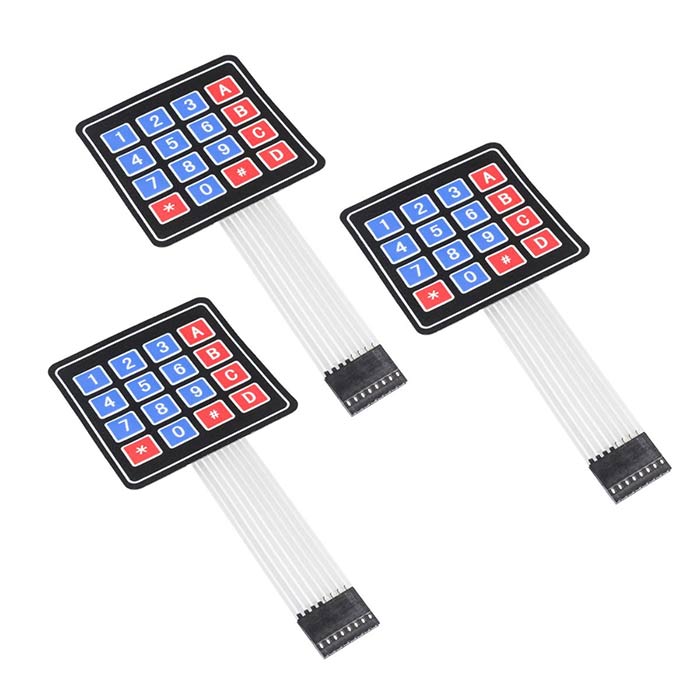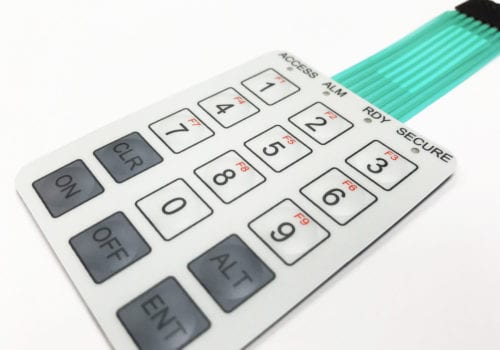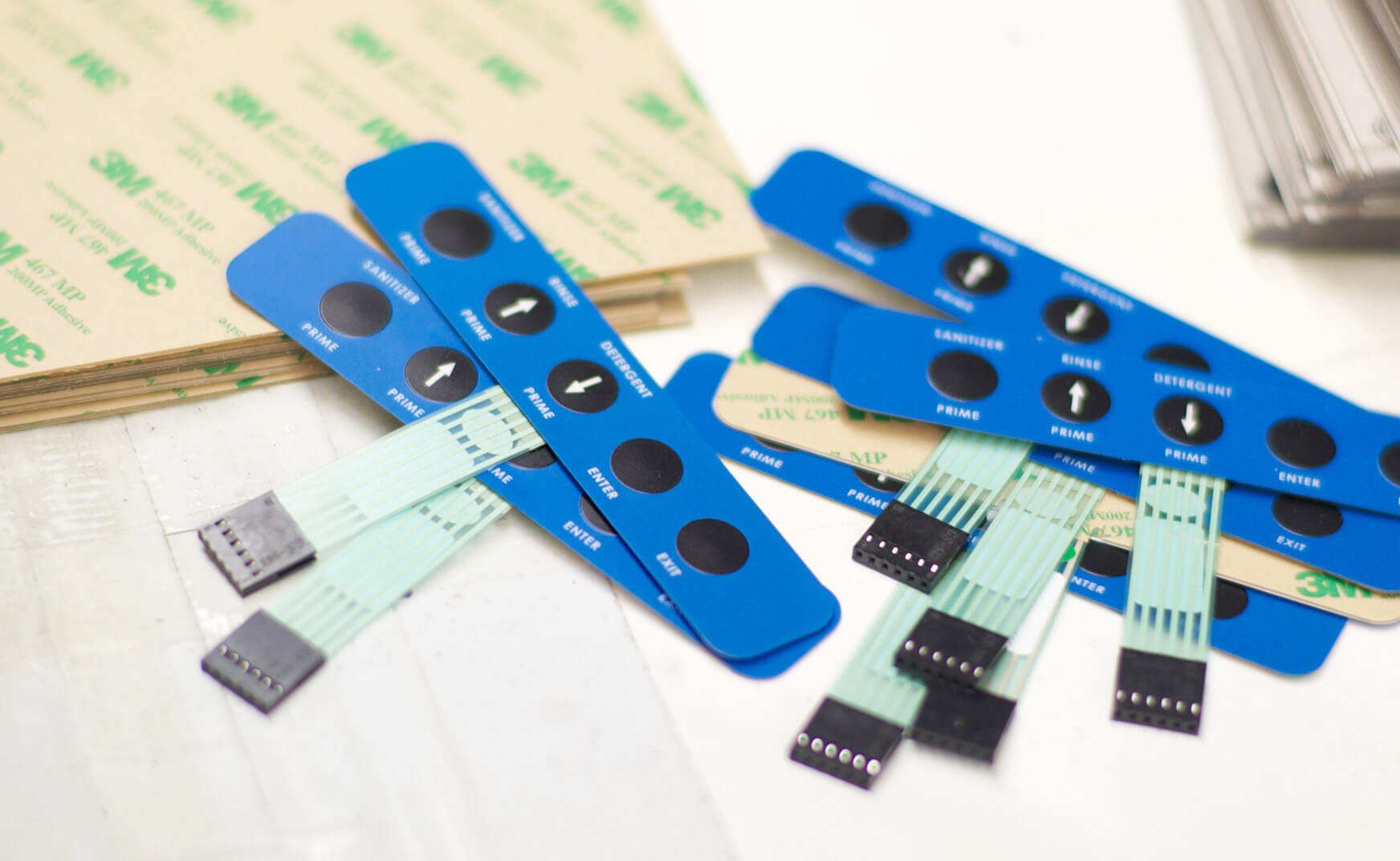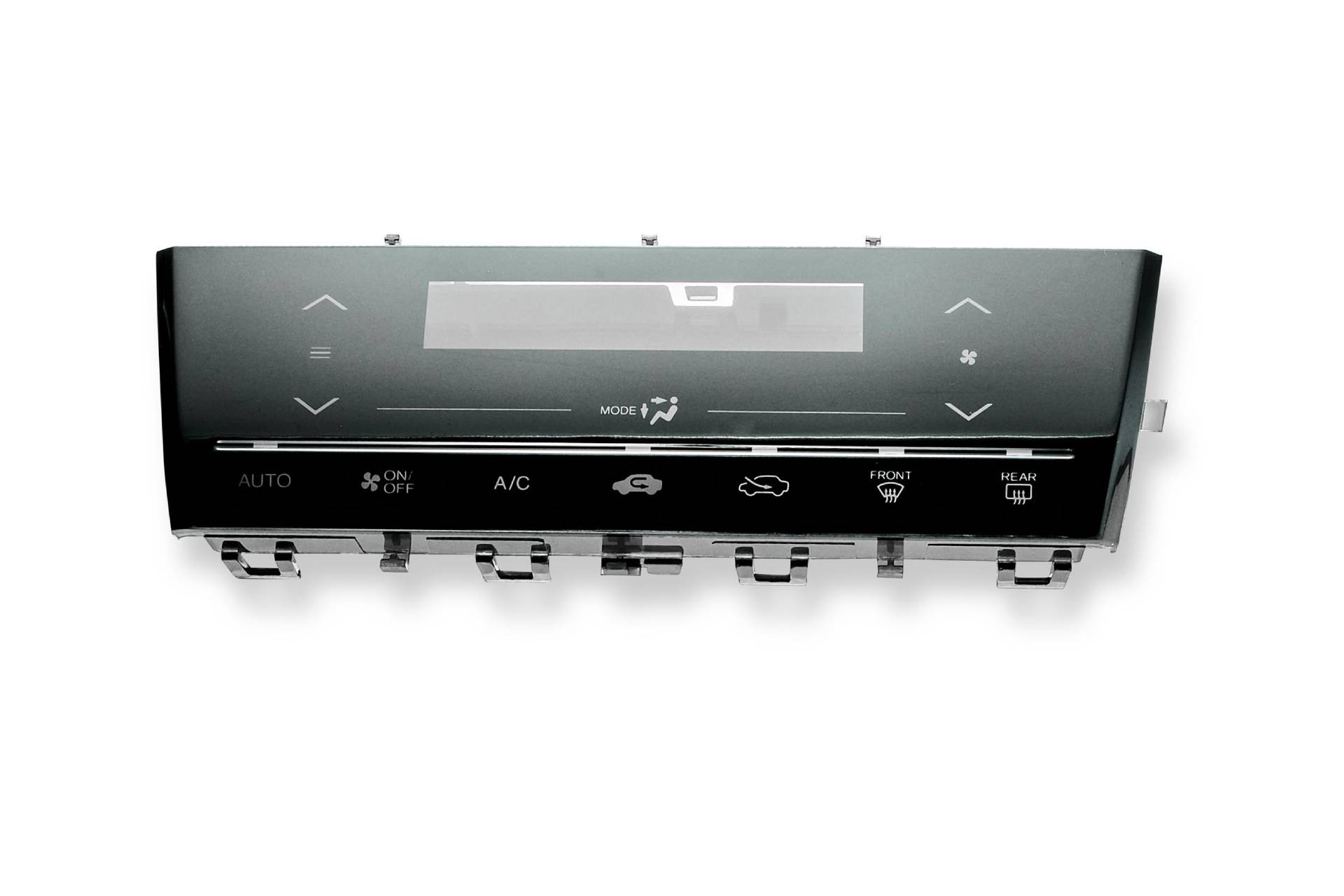What to Look for When Selecting a Membrane Layer Switch for Your Task
When you're picking a membrane layer button for your job, several essential elements come right into play. You'll require to consider the materials, design, and just how well it lines up with your brand name. Resilience and functionality are essential, however so is the track record of the maker. Understanding these components can assist you make a notified decision-- one that stabilizes high quality and cost successfully. Let's discover what you need to think about to assure your selection meets all your project requires.
Comprehending Membrane Layer Switch Over Components
When you plunge right into the globe of membrane buttons, it's necessary to grasp the vital parts that make them function. Below that, the spacer layer assurances there's adequate distance in between the circuit and the overlay, allowing the button to activate without constant pressure.
Comprehending just how these layers work together assists you choose a membrane button that's reliable and fits your project needs. Pay close focus to the density and material of each layer, as these variables influence sturdiness and capability in various atmospheres.
Product Choice and Its Impact
Choosing the right products for your membrane switch can greatly impact its performance and longevity. The choice of substrate, usually polyester or polycarbonate, influences resilience and versatility. Polyester is extra abrasion-resistant, while polycarbonate provides much better quality and stamina.
Following, consider the adhesive. It needs to withstand environmental factors like moisture and temperature modifications. A solid sticky assurances that your membrane layer switch remains intact in time.
Do not ignore the visuals overlay. The printing technique used, whether silkscreen or digital, influences the switch's looks and long life. High-grade inks will resist fading and scratching, preserving a specialist appearance.
Last but not least, consider environmental conditions. If your gadget will certainly be revealed to rough chemicals or severe temperatures, pick materials designed to withstand these challenges. Your options in materials will eventually identify the switch's integrity and customer contentment.
Style Factors To Consider for Customer Experience
Picking the appropriate materials lays the structure for a successful membrane layer button, but the design also plays a considerable role in individual experience. You'll want to review how the design influences usability (membrane switch manufacturer). Keep switches and symbols instinctive and well-spaced, making it easy for users to browse without complication

Color and contrast are likewise vital; guarantee that your layout is visually attractive yet still functional. High contrast aids customers easily determine buttons, especially in low-light problems.
Last but not least, show on the general aesthetic. A smooth and modern-day design can elevate user perception and make your item more appealing. Stabilizing capability with an appealing style will cause a much better user experience and eventually, a more effective item.

Environmental Elements and Longevity
When picking a membrane button, you need to take into account exactly how it'll execute in numerous atmospheres. Variables like temperature resistance, moisture and chemical direct exposure, and mechanical wear can significantly influence its toughness. Understanding these elements will certainly help you select a button that stands up to your details problems.
Temperature Resistance Requirements
As environmental conditions can vary commonly, comprehending temperature resistance is vital for guaranteeing the longevity of your membrane switch. Make certain to inspect the specs of the products made use of in the button, like the sticky and overlay, as they directly impact efficiency. By selecting a membrane layer switch with appropriate temperature level resistance, you'll boost its life-span and keep functionality in tough atmospheres.

Moisture and Chemical Exposure
Moisture and chemical exposure can substantially influence the performance and longevity of your membrane button, so it's vital to comprehend the setting in which it will be used. If your task entails high moisture or direct exposure to liquids, try to find protective coverings and sealers that can boost resistance to dampness. Additionally, take into consideration the kinds of chemicals your switch might experience. Specific materials can deteriorate when subjected to solvents, oils, or rough cleansers. Selecting the appropriate materials, like polycarbonate or polyester, can aid stand up to these aspects. Always consult the maker's specs for chemical compatibility to guarantee your membrane switch preserves its performance in time. By focusing on dampness and chemical resistance, you can boost the toughness of your switch in difficult environments.
Mechanical Use and Tear
While you may focus on functions like appearances and functionality in your membrane switch, mechanical wear and tear can greatly influence its efficiency over time. Regular pushing can lead to degradation of products, creating concerns like responsive comments loss or also switch over failure. Choosing a durable button assurances longevity and reliability, avoiding expensive substitutes and downtime in your project.
Customization Options for Branding
When it comes to branding your membrane switch, personalization alternatives are vital. You can pick style aspects and colors that mirror your brand name, in addition to particular logo design placement and dimension to improve visibility. In addition, picking the right products and structures can elevate the total look, making your product attract attention.
Design Elements and Colors
A broad range of style aspects and colors can make your membrane button not simply useful but likewise aesthetically attractive, boosting your brand name identity. Do not fail to remember about structures; adding a tactile aspect can boost customer experience and make your button stand out. By attentively picking layout components and colors, you not only develop a product that looks wonderful but likewise enhances your branding consistently and effectively.
Logo Placement and Dimension
After completing your layout aspects and shades, the next step is to focus on logo placement and dimension. Your logo is a vital aspect of your branding, so you'll desire it to stick out without overwhelming various other design components. Review where your logo will certainly be most visible and impactful; usual positionings include the top or center of the button.
Do not forget to contemplate exactly how the logo design straightens with individual interaction. This focus to detail will improve both performance and brand identity in your task.
Product and Appearance Choices
Selecting the right materials and appearances for your membrane button can substantially enhance both its functionality and aesthetic appeal. You'll intend to review options like polyester or polycarbonate, as they use resilience and resistance to wear. The texture of the surface area also plays an important function; smooth coatings give a streamlined appearance, while distinctive surfaces can enhance hold and tactile comments.
Customizing the materials and textures permits you to reflect your brand name identity effectively. For example, you could pick a matte surface to convey elegance or a glossy search for a contemporary touch - membrane switch Learn More manufacturer. Do not neglect about shade options, as vivid shades can make your button attract attention, while soft tones can produce a much more sophisticated look
Expense vs. High Quality: Discovering the Right Balance
When you're handling the options for membrane layer buttons, balancing expense and top quality can feel overwhelming. A lower-cost button could save you money upfront, but if it endangers functionality, you can deal with greater substitute prices later on.
Look for makers that provide a great mix of cost and high requirements. Research their online reputation and customer testimonials to determine reliability. Occasionally, investing a little bit extra in quality products can conserve you from future frustrations.
Also, take into consideration the long-term performance and guarantee alternatives. A slightly more pricey button with a strong service warranty can show to be a smarter financial investment. Ultimately, it's regarding locating that sweet place where you meet your spending plan while ensuring your project's success.
Checking and Quality Assurance Protocols
While you could discover the ideal membrane layer button layout, assuring its top quality via strenuous screening methods is essential for long-lasting success. Start by verifying that the manufacturer complies with industry standards, such as IPC/WHMA-A -620, to assure a trustworthy product. membrane switch manufacturer. You'll want to look for detailed testing methods, consisting of ecological, mechanical, and electrical analyses
Make sure the buttons undertake longevity screening, simulating real-world usage to identify any potential failures. Focus on the supplier's top quality assurance procedure, which ought to include routine assessments and audits.

Don't fail to remember to ask for samples and conduct your own examinations to verify compatibility with your task. Think about just how frequently the producer updates their methods; innovation in screening can lead to improved quality. By prioritizing these screening and quality control methods, you'll increase the likelihood of a successful and long lasting membrane button for your application.
Often Asked Concerns
The length of time Does a Membrane Layer Change Commonly Last?
A membrane layer button normally lasts anywhere from 1 to 10 million cycles, relying on usage and ecological variables. You'll intend to consider your particular demands to assure it meets your long life requirements successfully.
Can Membrane Layer Switches Be Repaired if Damaged?
Yes, you can in some cases repair membrane switches if they're harmed, yet it typically relies on the level of the damages. Small problems could be fixable, while much more considerable damages usually needs replacement for proper performance.
What Are the Usual Applications for Membrane Switches?
Membrane layer switches are commonly used in appliances, clinical tools, and automobile controls. You'll discover them in customer electronic devices, commercial equipment, and also gaming consoles. Their convenience makes see this them suitable for various individual interfaces and settings.
Are There Certain Accreditations for Membrane Layer Switches?
Yes, there specify certifications for membrane layer buttons. Search for UL, CE, and RoHS certifications to assure security and conformity. These certifications show the button fulfills industry standards for quality and environmental security.
How Do I Guarantee Proper Setup of a Membrane Change?
To ensure proper setup of a membrane layer button, clean the surface completely, straighten it thoroughly, and use even pressure. Follow manufacturer guidelines for sticky curing time to take full advantage of durability and capability.
Final thought
When choosing a membrane layer switch for your project, maintain these key variables in mind: prioritize long lasting products, emphasis on straightforward style, and take into consideration modification for your brand. Equilibrium cost and quality by researching reliable producers with strong quality control methods. By meticulously examining these elements, you'll guarantee your membrane button not only fulfills your job requires yet likewise improves user experience and mirrors your brand identification blog here properly. Make an enlightened choice, and your project will grow!